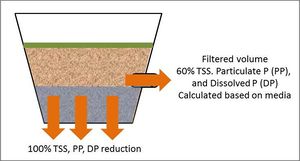
Difference between revisions of "Stormwater pollutant removal, stormwater credits"
(Created page with "File:schematic showing pollutant reduction calculations bioretention with underdrain.jpg|300px|thumb|alt=Schematic showing pollutant load reductions for infiltrated and filt...") |
m |
||
| Line 11: | Line 11: | ||
**[[Calculating credits for bioretention]] | **[[Calculating credits for bioretention]] | ||
**[[Calculating credits for green roofs]] | **[[Calculating credits for green roofs]] | ||
| − | **[[Calculating credits for infiltration | + | **[[Calculating credits for infiltration basin]] |
**[[Calculating credits for permeable pavement]] | **[[Calculating credits for permeable pavement]] | ||
**[[Calculating credits for tree trenches and tree boxes]] | **[[Calculating credits for tree trenches and tree boxes]] | ||
**[[Calculating credits for stormwater ponds]] | **[[Calculating credits for stormwater ponds]] | ||
**[[Calculating credits for stormwater wetlands]] | **[[Calculating credits for stormwater wetlands]] | ||
| − | **[[Calculating credits for sand | + | **[[Calculating credits for sand filter]] |
Revision as of 13:59, 18 May 2015
Credit refers to the stormwater runoff volume or pollutant reduction achieved toward meeting a runoff volume or water quality goal. Examples of goals include meeting the 1 inch volume reduction requirement in the Construction Stormwater General Permit and meeting TMDL pollutant reduction requirements. Credits can be achieved either by an individual BMP or cumulatively with multiple BMPs.
The following pages provide information on stormwater volume and pollutant credits, pollutant removal achieved by individual BMPs, methods for calculating volume and pollutant reductions (credits), and example calculations.
- Overview of stormwater credits
- Information on pollutant removal by BMPs
- Calculating stormwater volume and pollutant reductions and credits
- Credits for individual BMPs
- Calculating credits for bioretention
- Calculating credits for green roofs
- Calculating credits for infiltration basin
- Calculating credits for permeable pavement
- Calculating credits for tree trenches and tree boxes
- Calculating credits for stormwater ponds
- Calculating credits for stormwater wetlands
- Calculating credits for sand filter
